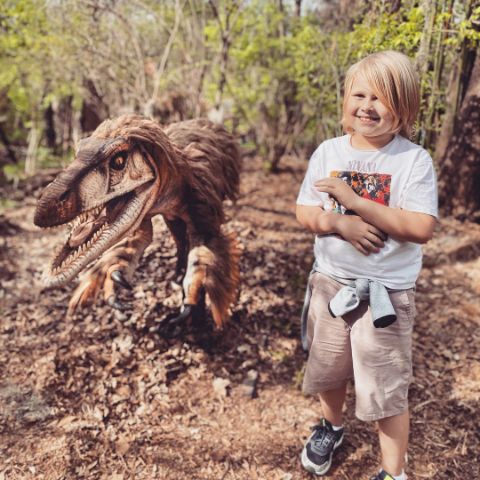DinoTrek Returns to Nashville Zoo
The Nashville Zoo will be hosting their fourth installation of DinoTrek from March 10 to July 30. The experience takes guests on a journey from the past through a wooded forest alongside more than 20 life-size animatronic dinosaurs that move, growl, hiss, roar and even spit.
What to Expect
Guests will embark from a hidden entrance near the Zoo’s Historic Grassmere Home and Farm and will discover life-like Jurassic beasts along a winding path. Educational signage will allow visitors to learn fun facts about each dinosaur. The dinosaurs are built on a steel frame by Texas-based Billings Productions Inc. and covered in intricately painted epoxy skin.
![]()
Species to See
New species include Brachiosaurus, Deltadromeus, Dimetrodon, Giganotosaurus, Iguanodon, Ornithomimus, Plateosaurus, Stegosaurus, Therizinosaurus and Triceratops. Returning favorites include Baryonyx, Coelophysis, Dilphosaurus, Megalosaurus, Pachyrhinosaurus and Tyrannosaurus Rex.
Dinosaurs Make a Roaring Return: A Look into the World of Prehistoric Reptiles
It’s hard to imagine a time when massive reptiles roamed the earth. Dinosaurs have long been extinct, having disappeared millions of years ago. However, thanks to advancements in technology and science, we can now bring dinosaurs back to life.
Dinosaurs have always fascinated humans. From the ferocious T-Rex to the gentle Brachiosaurus, these prehistoric creatures have captured our imaginations for centuries. However, it wasn’t until the late 1800s that dinosaur fossils were first discovered and properly identified.
Since then, scientists have been able to learn a great deal about these ancient reptiles through studying their fossils. Advances in technology have also allowed us to create better images and models of these creatures. Computer-generated imagery (CGI) has helped bring dinosaurs to life on the big screen in movies like Jurassic Park.
Now, there are even dinosaur parks and exhibits where visitors can see life-sized models of these creatures in person. For example, DinoPark in the Czech Republic features over 40 life-sized dinosaur models and offers interactive exhibits and activities for visitors.
But dinosaurs aren’t just being used for entertainment purposes. There is a growing interest in using their biology to better understand present-day animals and plants. This is known as paleobiology, the study of ancient life and ecosystems.
By analyzing dinosaur bones and other fossils, scientists can learn about their habitats, behaviors, and diets. This information can help us understand how these prehistoric creatures influenced the environment they lived in, and how their extinction affected other animals and plants.
Additionally, some scientists are using genetic techniques to study dinosaurs. In 2020, a team of researchers in Australia was able to extract soft tissue from a dinosaur fossil and sequence the proteins within it. This could lead to new insights into the genetics and biology of dinosaurs.
Overall, it’s clear that dinosaurs continue to fascinate us and offer a wealth of information for scientists to study. Whether it’s through entertainment or scientific research, dinosaurs will always have a place in our hearts and minds. So, let’s continue to explore this fantastic world of prehistoric reptiles and learn more about our planet’s past.

